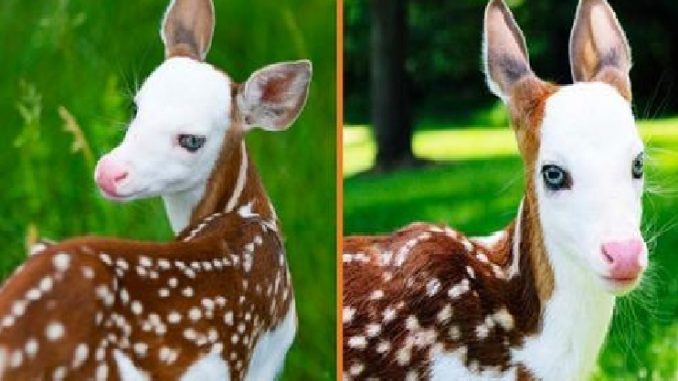Dragon the Piebald Deer is a piebald fawn who was rejected by his mother at birth and was rescued and raised by humans at Deer Tracks Junction in Augusta, Michigan in 2011. Background and Description
Dragon was abandoned by his mother and nursed by a cat.
Dragon is a ‘piebald’ deer meaning there are parts of his body with no pigmentation. In Dragon’s case, he has a white face and underbody.“Being a piebald causes many different health risks and a white-tail deer will instinctually reject any babies that do not have a good chance of survival,” said Hilary Powell, the owner of Deer Tracks Junction.
“The white makes him stand out so he can’t hide from predators, and he can’t hear or see as well as a regular deer, so he can’t hear or see predators coming.” She added that his mother had given birth to a brown fawn at the same time and was raising him fine.
Nevertheless, at first Dragon seemed to be “thriving,” said Powell. Dragon was named by Powell’s almost 19 year-old-son because, “he knew that he would need to be tough to survive”.
Only around one percent of deer have white piebald faces, which makes them very rare. Even fewer survive in the wild after the mother rejects them. Popular Culture
At one time Dragon had nearly 30,000 fans as far away as Egypt and Romania on his official Facebook page.
Of his many fans, few were more ardent than a woman from Utah who dressed as a fairy godmother for a Facebook picture encouraging the little deer to get well.
An e-mail campaign on behalf of Dragon reached as far as Japan.
Dragon also made the rounds of YouTube and became a television star after Today Show regular Dr. Rene Hackney visited the deer at the Deer Tracks Junction.
Unfortunately, just before that television appearance, on April 15, 2012, Dragon died of pneumonia. Hilary Powell wrote on Facebook:
“Well, sadly, this is an update that I never wanted to have to make. Despite all medical intervention available, we lost our little Dragon. It has been a tough time here, and he will be greatly missed by all.”
[!Her son Samuel posted the following: “I was with him all day Monday and took turns holding him throughout the night. He finally passed away on Tuesday morning at about 7:00 am with Hilary and I there holding him. I cannot express how hurt Hilary was and is about losing him, and I have never wanted to do anything more [than succeed] in my life then I did get Dragon to get better. But it was his time and we need to remember what an awesome impact he had on all our lives in this world.”]
Deer Tracks Junction used the publicity surrounding Dragon’s death to promote its fund-raising for Paws With a Cause, a Michigan organization that trains assistance dogs. Powels said on Facebook, “Whether it’s a trained guide dog for a blind or deaf person, or a trained emergency medical retrieval dog, or a service dog who can provide stamina and balance for someone with a disability or PTSD, or a companion dog who can help an autistic child…. The list goes on and on!
6 Most Common Cat Health Problems
Cats are good at self-maintenance. But even your fastidious feline can’t prevent some of these more common cat diseases and health issues.
1. Vomiting
Vomiting is a very common problem with cats with a multitude of causes. They range from eating something poisonous or inedible (like string), to infection, urinary tract disease, or diabetes to hairballs.
2. Feline Lower Urinary Tract Diseases (FLUTD)
TSome estimates say as many as 3% of cats seen by vets have feline lower urinary tract disease (FLUTD), which is actually a group of feline diseases with multiple causes.
List bellow:
Drinking more
Straining to urinate
Bloody urine
Urinating in unusual places
Crying when urinating
Licking around the urinary area (often because of pain)
3. Fleas
Fleas are a very common external feline health problem. But it’s one you can easily treat. Signs your cat has fleas include:
Flea dirt on its skin (they look like tiny black dots)
Constant scratching
Frequent licking
Red or irritated skin
Hair loss
Skin infections or hot spots
